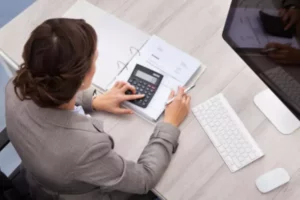Content

The standardized accounting cycle process (supported by accounting systems) is important because it helps business owners, small businesses, and established companies close their books for the accounting period. It also helps to generate financial information to perform financial statement analysis and manage the business. Additional transactions or activities of the corporation revealed $800 in Accounts Receivables and $100 in inventory, in addition to a $600 cash debit.
- Typically, companies integrate their accounting software with their payment processor and point-of-sale (POS) software to capture revenue.
- Companies may follow cash accounting or accrual accounting, or choose between single-entry and double-entry accounting.
- Throughout this section, we’ll be looking at the business events and transactions that happen to Paul’s Guitar Shop, Inc. over the course of its first year in business.
- The next step is to record your financial transactions as journal entries in your accounting software or ledger.
- Exactly when the transaction is recorded depends on whether the business prefers the accrual accounting method (as most do) or the cash accounting method.
- Sign up for Shopify’s free trial to access all of the tools and services you need to start, run, and grow your business.
- You need to calculate the trial balance at the end of the fiscal year.
Automation eliminates the need for a significant amount of manual intervention, therefore expediting the process so businesses can close their books with confidence. It starts with recording all financial transactions throughout that accounting period and ends with posting closing entries to close the books and prepare for the next accounting period. It’s worth noting that some businesses also have internal accounting cycles that have a shorter accounting period.
Prepare Journal Entries
The main difference between the accounting cycle and the budget cycle is the accounting cycle compiles and evaluates transactions after they have occurred. The budget cycle is an estimation of revenue and expenses over a specified period of time in the future and has not yet occurred. A budget cycle can use past accounting statements to help forecast revenues and expenses. Whether one employs a single-entry or double-entry accounting system, one must apply a debit or credit to every transaction.
It also helps to ensure consistency, accuracy, and efficient financial performance analysis. At the end of the accounting period, a trial balance is calculated as the fourth step in the accounting cycle. A trial balance tells the company its unadjusted balances in each account.
Closing the Cycle
The accounting cycle is a system of recording, processing, summarizing and communicating all financial transactions in a consistent way. It starts when a transaction occurs, and ends with its representation on financial statements. Once the cycle concludes, steps are taken to begin the next accounting cycle. Based on the transactions recorded as part of the accounting cycle, financial statements such as cash-flow reports, profit-and-loss statements, and balance sheets can be prepared. The last step in the accounting cycle is to make closing entries by finalizing expenses, revenues and temporary accounts at the end of the accounting period. This involves closing out temporary accounts, such as expenses and revenue, and transferring the net income to permanent accounts like retained earnings.
- Skipping steps in this eight-step process will likely lead to an accumulation of errors.
- But the cash flow statement is equally important to help you understand how your net income and the activity in the cash account compare.
- No, there is an entire market for selling gift cards on Craigslist, just go look and see how easy it is to buy discounted gift cards on Craigslist.
- All transactions during an accounting period must be recorded in a journal.
- All temporary accounts should have been taken care of with the closing entries.
In addition to identifying any errors, adjusting entries may be needed for revenue and expense matching when using accrual accounting. This trial balance should contain zero balances for all temporary accounts. Accountants study the respective statements after they have been created to identify trends indicated by the recorded accounting operations. Next, based on the analysis, they communicate their findings to managers and other stakeholders, who use the data to assess the performance of the businesses and make well-informed and productive decisions. For example, in the previous transaction, Supreme Cleaners had the invoice for $200.
Develop the Chart of Accounts for your Small Business
Most companies seek to analyze their performance on a monthly basis, though some may focus more heavily on quarterly or annual results. The eight-step accounting cycle is important to know for all types of bookkeepers. It breaks down the entire process of a bookkeeper’s responsibilities into eight basic steps. Many of these steps are often automated through accounting software and technology programs. However, knowing and using the steps manually can be essential for small business accountants working on the books with minimal technical support. The firms compile the relevant financial statements after cross-checking the accounting details and correcting inaccuracies.
However, today these steps are occurring with electronic speed and accuracy within sophisticated yet inexpensive accounting software. The accountant can enter adjusting entries into the software and can instantaneously obtain a complete set of financial statements by simply selecting them from a menu. After reviewing the financial statements, the accountant is able to make additional adjustments and almost immediately obtain the revised reports. The software will also prepare, record, and post the closing entries. It will also reverse adjusting entries that have been designated to be reversed. After you complete your general ledger entries for an accounting cycle, the next step is to prepare a trial balance.
Free Debits and Credits Cheat Sheet
Bench assumes no liability for actions taken in reliance upon the information contained herein. Tax adjustments help you account for things like depreciation and other tax deductions. For example, you may have paid big money for a new piece of equipment, but you’d be able to write off part of the cost this year.
What is Step 5 in accounting cycle?
Here are the steps in the accounting cycle:
Step 2: Record journal entries. Step 3: Post journal entries to the general ledger (G/L) Step 4: Run unadjusted trial balance. Step 5: Make adjusting entries.
It is useful to print out the key documents supporting the completed financial statements and store them in a binder. This can include all journals, as well as source documents for major journal entries, such as the depreciation calculations. This information provides backup information for the financial statements, and is of particular use when providing evidentiary matter to auditors. On March 15, 2022, A Company called JTP got $500 for its software goods and logged the transaction. The sum is credited to the Sales Revenue account and debited from the cash account.
Recording entails noting the date, amount, and location of every transaction. Next, you’ll break down (or analyze) the purpose of each transaction. Between managing supplies and satisfying customers, the last thing you need to worry about is an accounting error (or any error for that matter). With the right processes and tools in place, you can be equipped to handle any challenge that might come your way.
Stop wasting time worrying about the books when we can do them for you. Set up a free virtual meeting with us to get the advice you need for your business. The sequence of accounting procedures used to record, classify and summarize accounting information is called the Accounting Cycle. Sign up for Shopify’s free trial to access all of the tools and services you need to start, run, and grow your business. Try Shopify for free, and explore all the tools and services you need to start, run, and grow your business. Moreover, if you have inaccurate information, you might inadvertently mislead your lenders, creditors and investors, which can have serious legal consequences.
Once transactions are recorded in journals, they are also posted to the general ledger. A general ledger is a critical aspect of accounting, serving as a master record of all financial transactions. Your accounting type and method determine https://www.bookstime.com/articles/accounting-cycle when you identify expenses and income. For accrual accounting, you’ll identify financial transactions when they are incurred. Cash accounting, on the other hand, involves looking for transactions whenever cash changes hands.

The purpose of this is to look them over and then decide what effect they have had on company accounts. This is a method to track all the transactions by recording them in chronological order as they take place. Entries that are recorded are usually separated into credit and debit along with the date and a summary of the transaction.
Accounting Cycle Definition: Timing and How It Works
Accounting cycle is a process of a complete sequence of accounting procedures in appropriate order during each accounting period. The accounting process is a combination of activities that begin when a transaction occurs and end with its inclusion in the financial statements at the end of the accounting period. All the debit balances are added and compared to the total of all the credit balances. The sole purpose of this report is to confirm that total debits equal total credits.
How many accounting periods are there?
Many businesses use 12 accounting periods per year, or one per month. However, having monthly accounting periods with varying days (e.g., 30 days vs. 31 days in a month) can throw off financial reports.